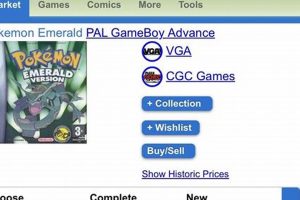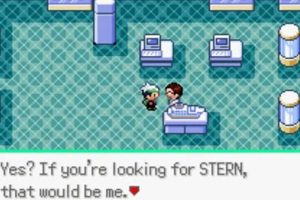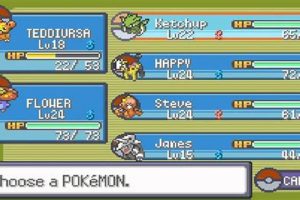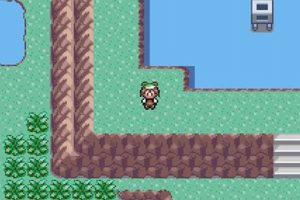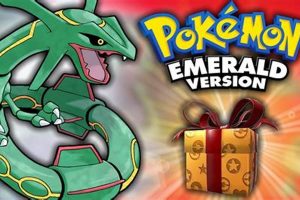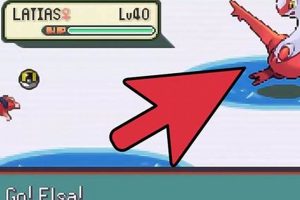The process of transferring Pokmon between the GameCube title, Pokmon Colosseum, and the Game Boy Advance title, Pokmon Emerald, involves specific hardware and in-game steps. Success depends on utilizing the Game Boy Advance link cable to connect the GameCube console to the Game Boy Advance. This connectivity enables the exchange of Pokmon captured or purified in Colosseum for use within the Emerald game.
The ability to migrate Pokmon between these games provides players with increased team customization options, access to Pokmon not native to a particular title, and the opportunity to complete the Pokdex within Pokmon Emerald. Historically, this inter-game communication was a key feature of the third generation of Pokmon games, encouraging players to engage with multiple titles within the franchise.
This article will detail the precise equipment required, the necessary in-game progress to unlock the trading function, and the step-by-step instructions for successfully completing the Pokmon transfer procedure from Colosseum to Emerald. The intricacies of the trading mechanic and any potential troubleshooting steps will also be discussed.
Tips for Successful Pokémon Transfer
The following tips can enhance the efficiency and minimize potential errors during the Pokémon transfer process from Pokémon Colosseum to Pokémon Emerald.
Tip 1: Verify Hardware Compatibility: Ensure the Game Boy Advance link cable is specifically designed for connecting a Game Boy Advance to a GameCube. Incompatible cables may fail to establish a stable connection.
Tip 2: Progress Sufficiently in Both Games: In Pokémon Colosseum, purify the desired Pokémon and reach the point where trading becomes available. In Pokémon Emerald, defeat the first Gym Leader to unlock the Pokémon Center trading functionality.
Tip 3: Save Before Initiating the Trade: Save both the Colosseum and Emerald game files before commencing the trade. This allows for reverting to a previous state should any errors occur during the transfer process.
Tip 4: Inspect Pokémon IVs/EVs Carefully: Before trading, evaluate the Individual Values (IVs) and Effort Values (EVs) of the Pokémon. Consider whether these stats align with the intended use of the Pokémon in Pokémon Emerald.
Tip 5: Ensure Pokémon are Trade-Eligible: Confirm that the Pokémon being transferred do not possess any held items and meet all trade restrictions within the respective games.
Tip 6: Maintain a Stable Connection: Avoid any movement or interference with the Game Boy Advance link cable during the trading process to prevent disconnection errors.
Tip 7: Understand Move Compatibility: Moves learned in Colosseum may not exist in Emerald. The Pokémon will retain any moves it knows that are compatible with the Emerald movepool, and any moves it knows that are incompatible will be removed.
Utilizing these tips should promote a seamless and error-free exchange of Pokémon between Pokémon Colosseum and Pokémon Emerald, maximizing the benefits of cross-game functionality.
The subsequent section will address common troubleshooting steps encountered during this trading procedure, helping to resolve connectivity or other operational issues.
1. Hardware Requirements
The ability to transfer Pokémon from Pokémon Colosseum to Pokémon Emerald is predicated on specific hardware components. The presence and correct functionality of these items are non-negotiable for successful execution of the trade process.
- Nintendo GameCube Console
The Nintendo GameCube serves as the host platform for Pokémon Colosseum. This console must be in proper working order, capable of reading GameCube game discs, and possessing functional controller ports to facilitate player input.
- Game Boy Advance (GBA) or Game Boy Advance SP Console
Pokémon Emerald runs on the Game Boy Advance or Game Boy Advance SP. The handheld console needs to be fully operational with a functioning cartridge slot to read Game Boy Advance game paks. Battery life or power source is also a critical consideration.
- Game Boy Advance Link Cable
This specialized cable provides the physical connection between the Nintendo GameCube and the Game Boy Advance. A genuine Nintendo or officially licensed link cable is recommended to ensure data transfer compatibility. Third-party or generic cables may exhibit inconsistent performance or complete failure.
- Pokémon Colosseum Game Disc & Pokémon Emerald Game Pak
Both the GameCube disc of Pokémon Colosseum and the Game Boy Advance game pak of Pokémon Emerald must be authentic and in good working condition. Damaged, counterfeit, or unreadable media will prevent the trading process from initiating.
The absence of, or malfunction of, any of these hardware elements will render the Pokémon transfer from Colosseum to Emerald impossible. Proper identification, maintenance, and verification of functionality are therefore paramount to achieving the desired outcome.
2. In-Game Progress
The ability to execute a Pokémon transfer from Colosseum to Emerald is intrinsically linked to specific milestones achieved within each respective game. This connection is not arbitrary; it serves as a mechanism to prevent early exploitation of trading functionalities and to ensure players engage with the core gameplay elements before accessing advanced features. The consequences of neglecting these progression requirements are straightforward: the trading option remains unavailable, rendering the transfer process impossible. For example, attempting to initiate a trade in Emerald before defeating the first Gym Leader will fail, regardless of having the correct hardware and a link cable connection.
In Pokémon Colosseum, progression necessitates purifying shadow Pokémon to the point where they can be traded. Furthermore, the player must advance the storyline sufficiently to unlock the trading interface within the Phenac City Pokémon Center. In Pokémon Emerald, the prerequisite is defeating the Rustboro City Gym Leader, Roxanne. This unlocks the ability to use the Trading Center within any Pokémon Center. Without meeting these criteria, the games will not recognize the presence of a compatible partner game and thus, will not initiate the trading sequence. In effect, “In-Game Progress” functions as a gatekeeper, enforcing a minimum level of engagement before allowing access to cross-game trading.
In summary, “In-Game Progress” acts as a critical prerequisite for the transfer process. Failure to meet the in-game milestones in either Colosseum or Emerald will prevent the trading function from becoming accessible. This highlights the importance of both understanding and fulfilling the progression requirements as an essential step in enabling the inter-game transfer of Pokémon, ultimately enhancing the player’s overall experience and options within the broader Pokémon universe.
3. Link Cable Connection
The physical connection established by the Game Boy Advance link cable is paramount to the process of transferring Pokémon from Pokémon Colosseum to Pokémon Emerald. This cable serves as the sole conduit for data transmission between the GameCube and the Game Boy Advance, enabling the inter-game communication necessary for trading.
- Cable Type and Compatibility
The specific type of link cable required is a Game Boy Advance link cable designed to connect to the GameCube. While seemingly straightforward, compatibility issues can arise with third-party cables or those intended for different Game Boy Advance models. Utilizing an incorrect or faulty cable will prevent the establishment of a stable connection, thereby halting the trade process. For example, a Game Boy Color link cable will not function with the Game Boy Advance and GameCube.
- Connection Stability and Interference
Maintaining a stable connection throughout the trade is critical. Movement or physical interference with the cable during data transfer can result in disconnection errors and potential data corruption. It is advisable to position the GameCube and Game Boy Advance on a stable surface, minimizing the risk of accidental disconnections. External electrical interference could also disrupt data transmission.
- Proper Port Insertion
The link cable must be fully and correctly inserted into the designated ports on both the GameCube and the Game Boy Advance. A loose or partially inserted cable may provide an intermittent connection, leading to errors during the trade. Care must be taken to align the cable connector correctly with the port to avoid damaging the pins.
- Impact on Data Transfer Rate
The link cable’s quality and condition can influence the data transfer rate. A damaged or low-quality cable may result in slower transfer speeds, increasing the risk of errors during the trading process. While not directly impacting the success of the trade, a slower transfer rate can significantly extend the time required to complete the process.
In summary, the link cable connection represents the indispensable physical link between the two gaming systems. Ensuring compatibility, maintaining stability, verifying proper insertion, and considering the potential impact on data transfer rates are all crucial elements in leveraging the link cable to successfully perform the trade of Pokémon from Colosseum to Emerald. These factors, when addressed correctly, minimize potential errors and contribute to a seamless and efficient trading experience.
4. Pokmon Eligibility
The process of transferring Pokémon from Colosseum to Emerald is not universally applicable to all Pokémon within the Colosseum game. A key determinant of whether a creature can be moved rests on “Pokémon Eligibility,” a multi-faceted criterion that dictates which Pokémon are permitted to participate in inter-game trading.
- Purification Status
Shadow Pokémon, the primary type of Pokémon encountered in Colosseum, are inherently ineligible for trade. These Pokémon must undergo a purification process to remove the shadow taint before they can be transferred to Emerald. This purification process involves battling with the Shadow Pokémon, carrying them in the player’s party, and using specific in-game methods to reduce the Pokémon’s heart gauge to zero. Only fully purified Pokémon meet the eligibility requirements for trade, ensuring they are in a stable and uncorrupted state for transfer. A Shadow Lugia, for example, cannot be transferred until the purification process is complete.
- Game-Specific Restrictions
Certain Pokémon may be subject to specific restrictions within Colosseum that prevent their trade, regardless of purification status. This may be due to their role in the game’s storyline, or unique characteristics that make them ineligible for migration to Emerald. For example, a specific event Pokémon distributed only within Colosseum may have a flag set that prevents it from being traded, even if it has been purified. These restrictions are coded directly into the game and cannot be circumvented through normal gameplay mechanics.
- Held Items
Pokémon holding items are generally ineligible for trade. Prior to initiating the trade process, any held items must be removed from the Pokémon. While the presence of a held item does not permanently disqualify a Pokémon from being traded, failure to remove the item will prevent the trade from occurring until the condition is rectified. This measure is in place to prevent the duplication of items or the introduction of incompatible items into the Emerald game. For example, if a purified Metang is holding a Quick Claw, the item must be removed before the Metang can be traded.
- Game Compatibility Checks
The games themselves perform compatibility checks to ensure the integrity of the trade process. These checks may involve verifying that the Pokémon is not corrupted, that it meets the level requirements for trade, or that it does not possess any illegal moves or abilities. If a Pokémon fails these compatibility checks, it will be deemed ineligible for trade, and an error message will be displayed. This mechanism helps prevent the introduction of hacked or glitched Pokémon into the Emerald game, maintaining a degree of quality control over the trading process. A Pokémon with altered stats, for example, would be rejected.
The described facets of “Pokémon Eligibility” underscore its integral role in the broader context of transferring Pokémon from Colosseum to Emerald. Failure to adhere to these eligibility requirements will invariably result in the failure of the transfer process, highlighting the need for a thorough understanding of the conditions governing which Pokémon are deemed suitable for inter-game trade. Thus, the game mechanics are designed to provide an element of quality control to the creatures available in Emerald and Colosseum.
5. Trading Mechanics
The successful execution of “how to trade pokemon from colosseum to emerald” hinges directly on a comprehensive understanding of in-game “Trading Mechanics.” These mechanics dictate the protocols and procedures for initiating and completing a transfer between the two games. Without adhering to the specified steps within the Pokémon Centers, the physical link and game progression become irrelevant. A player could possess the correct hardware and have fulfilled all story prerequisites, but if unaware of the precise sequence of actions within the trading interface, the Pokémon transfer will not occur.
Specifically, within Colosseum, a player must speak to the non-player character (NPC) responsible for initiating link trades, selecting the option to connect to a Game Boy Advance game. Simultaneously, the Emerald player must enter a Pokémon Center and interact with the Link Cable Time Capsule machine. Both games must then be set to “wait” or “search” for a trade partner. Initiating the trade too early, or selecting an incorrect option within the menu, will lead to connection failure. This exemplifies how precise adherence to the “Trading Mechanics” is not merely a suggestion, but a prerequisite for successful transfer.
In summation, the in-game “Trading Mechanics” represent the actionable steps required to complete the transfer process. While hardware and game progression establish the potential for trade, it is the correct implementation of these “Trading Mechanics” that ultimately determines its success. Consequently, a detailed comprehension of these in-game procedures is vital for anyone seeking to transfer Pokémon from Colosseum to Emerald. Failure to understand and correctly execute these steps will invariably result in an unsuccessful transfer attempt.
6. Troubleshooting Steps
The successful transfer of Pokémon from Colosseum to Emerald is not always a straightforward process. Various technical and in-game factors can impede the trading procedure, necessitating a systematic approach to problem identification and resolution. “Troubleshooting Steps” are therefore an integral component of the overall process, ensuring that unforeseen obstacles do not prevent the completion of the transfer. The absence of effective troubleshooting can render even the correct hardware and game progression useless.
- Link Cable Connectivity Issues
A common impediment is a faulty or improperly connected link cable. The cable must be securely plugged into both the GameCube and Game Boy Advance. Damage to the cable, such as frayed wires or bent connectors, can disrupt the data transmission. Replacing the link cable with a known working one can resolve this issue. An intermittent connection can be indicated by trade errors; reseating the cable often alleviates such issues. A visual inspection of the connector pins can reveal damage.
- Game Compatibility Problems
Discrepancies between game versions or the presence of bootleg copies can lead to incompatibility errors. The software on both systems must be genuine and undamaged. Attempts to trade with a counterfeit copy of either Colosseum or Emerald will almost certainly fail. Verifying that both games are authentic licensed products is a fundamental troubleshooting step. Corruption of the save data in either game can also cause trading errors.
- In-Game Progression Requirements Not Met
Failure to meet the specific in-game progression milestones in either Colosseum or Emerald will prevent trading. In Colosseum, the player must progress far enough to unlock trading functionality within Phenac City. In Emerald, defeating Roxanne, the first Gym Leader, is a prerequisite. Confirming that these milestones have been achieved is a crucial step. Attempting to trade before these prerequisites are met generates consistent errors.
- Pokémon Eligibility Restrictions
Not all Pokémon are eligible for trade. Shadow Pokémon in Colosseum must be purified before they can be transferred. Pokémon holding items cannot be traded until the items are removed. Understanding these restrictions and verifying that the Pokémon meet the eligibility criteria is essential. Failure to adhere to these limitations consistently results in trading errors. Specific Pokémon flags also prevent legitimate trading in rare circumastances
These “Troubleshooting Steps” represent a methodical approach to resolving common issues encountered during the Pokémon transfer process. By systematically addressing potential hardware, software, and in-game factors, players can increase their chances of successfully trading Pokémon from Colosseum to Emerald. In cases where typical errors persist, consulting online forums or dedicated Pokémon communities may provide solutions specific to less common problems, further illustrating the community involvement of Pokémon’s troubleshooting aspects.
Frequently Asked Questions
This section addresses common inquiries regarding the process of transferring Pokémon between Pokémon Colosseum and Pokémon Emerald, providing clear and concise answers to potential concerns.
Question 1: Is a specific type of Game Boy Advance link cable required for the transfer?
A Game Boy Advance link cable specifically designed for connecting to the Nintendo GameCube is required. Standard Game Boy Advance link cables intended for connecting two Game Boy Advance systems are incompatible and will not facilitate the trade.
Question 2: What in-game progress is necessary in Pokémon Colosseum to enable trading?
The player must progress through the main storyline until reaching Phenac City and activating the trading functionality. Shadow Pokémon must be purified before being eligible for trade.
Question 3: What in-game progress is necessary in Pokémon Emerald to enable trading?
The player must defeat Roxanne, the Gym Leader of Rustboro City. This action unlocks the trading center feature within Pokémon Centers across the region.
Question 4: Are all Pokémon obtained in Pokémon Colosseum eligible for transfer to Pokémon Emerald?
Only purified Pokémon are eligible for transfer. Shadow Pokémon, by definition, cannot be traded until the purification process is complete. Some specific event or story-related Pokémon may also be restricted.
Question 5: What steps should be taken if the connection between the GameCube and Game Boy Advance fails during the trading process?
First, verify that the link cable is securely connected to both systems. Second, restart both the GameCube and Game Boy Advance. Third, inspect the link cable for any signs of damage. If the problem persists, try using a different link cable known to be functional.
Question 6: What happens to a Pokémon’s moveset if a move learned in Colosseum is not compatible with Pokémon Emerald?
Incompatible moves will be removed from the Pokémon’s moveset upon transfer to Pokémon Emerald. Compatible moves will be retained. It is advisable to review the move compatibility lists before initiating the transfer to avoid losing desired moves.
These FAQs aim to provide a clear understanding of the transfer process and address potential challenges that may arise. Adhering to the specified requirements and troubleshooting steps will maximize the likelihood of a successful Pokémon transfer.
The next section will provide a concluding summary of the key information and best practices for transferring Pokémon from Colosseum to Emerald.
Concluding Remarks
This exploration of “how to trade pokemon from colosseum to emerald” has detailed the essential prerequisites, including hardware compatibility, in-game progress, Pokémon eligibility, and the intricacies of the trading mechanics. Successful transfer hinges upon meticulous adherence to these guidelines. Potential issues, such as link cable malfunctions or unmet in-game requirements, necessitate a systematic troubleshooting approach.
The ability to transfer Pokémon between these titles represents a unique interaction within the third generation of Pokémon games. Mastering this process allows for greater team customization and expands the scope of gameplay. Individuals are encouraged to carefully review the outlined steps to maximize the benefits of this cross-game functionality and ensure a seamless transfer experience, thus furthering the enjoyment of both Pokémon Colosseum and Pokémon Emerald.


